Old Galway
THE FISHMARKET
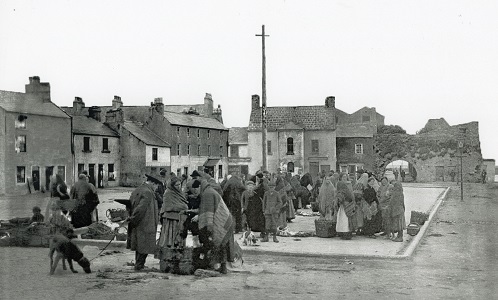
by Tom Kenny
It is a pity really that we cannot see this photograph in colour because what we are looking at must have been a wonderful, colourful, animated scene full of black shawls, patterned and coloured shawls, blue cloaks and red cloaks, white aprons, práiscíns, baskets, scibs, barrels, fisherwomen from the Claddagh, customers from the town. Imagine the noisy competition between the sellers, the lively female eloquence, the haggling ...“Fresh fish, Johnny Dory, Lovely Mackerel” etc. It all sounds like great fun and very romantic but of course it was vital for the Claddagh women who were trying to make a living, to make enough to support their families.
BUTTERMILK LANE
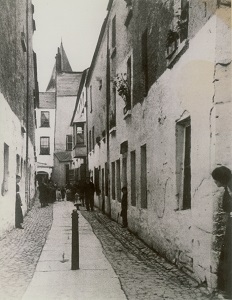
by Tom Kenny
At the time this photograph was taken about one hundred years ago, Buttermilk Lane was made up of tenement buildings some of which housed multiple families. For example, three families lived in Number 2 in 1911; three in Number 4; five in Number 6. There were people with nine different surnames in Number 7 and eight different surnames in Number 8.
Among those who lived on the right were Connollys who were shoemakers; Kennedys ; McDonaghs ; another Connolly who had a little grocery shop ; Haynes’ . Tom Daly lived around the corner and the rooms over him were occupied by the Kelly family. Michael Hehir lived on the left hand side as did Patrick Murphy; Mrs. King and her son Tommy; Mrs. Cox; Mr. Burns, a tinsmith ; Mr. Barrett lived at the end and Mrs. Connolly at the top.
THE DYKE ROAD
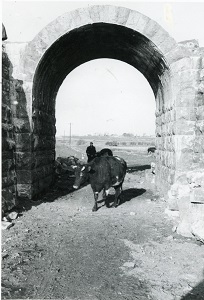
by Tom Kenny
The Dyke Road was originally known as ‘The Terryland Embankment’. In 1847, a group known as The Corrib Development Company applied for compensation claiming they had spent a considerable sum constructing the embankment --- at the time the river was very prone to serious flooding. The Commissioner for Public Works took over possession of the works after giving evidence in reply to the claim for compensation. They pointed out that the embankment was partially built in 1839, but after the water had risen that winter, it had given way. The Company carried out more works of reconstruction in 1840, but the flood waters burst it again. The river would flood on each occasion as far as Castlegar. The embankment was left unfinished until 1845 when the Company tried once more but failed to retain the river. They were subsequently compensated. The building of the canal a few years later greatly alleviated the flooding problems.
ST. ANNE’S ORPHANAGE
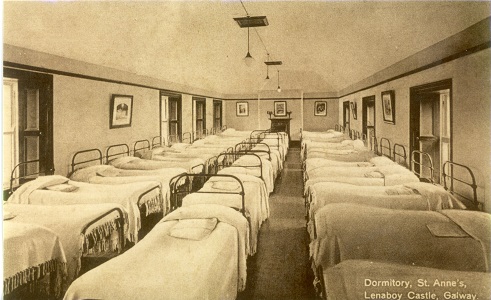
by Tom Kenny
St. Anne’s was situated in Lenaboy Castle on Taylor’s Hill. The old part of that building dates from the early 18th century. The house, which was situated on 63 acres of land, belonged to Colonel James O’Hara who was, in 1885, Chairman of the Town Commissioners and who founded a number of Galway industries. A lane led from the house to the gate of the estate which was beside where the Warwick Hotel is today.
CALLING ALL JES OARSMEN AND WOMEN

by Tom Kenny
Rules governing the rowing of schoolboys were formalised by the Irish Amateur Rowing Union in 1927, and rowing schools began to make more frequent appearances at regattas. The Jes had been closed for a number of years due to a lack of numbers but it reopened in 1929. Five years later, a group of pupils met in Keogh’s Shop beside the school (where Kai is today) to discuss the idea of forming a school rowing club. As there was no one in the school to take charge, their application was turned down. They were persistent, however, and in October of that year, 1934, they made another appeal and this time they were successful. They had to put together a crew, find a coach, get a boat and a base on the river to start.
THE DIVING TOWER AT BLACKROCK
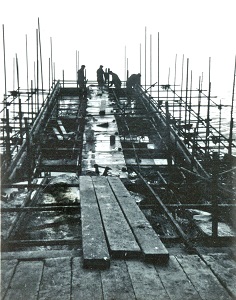
by Tom Kenny
The warm summer of 1885 encouraged Mr. Moon and his friends to place a springboard at Blackrock where there is a tidal range of 17’3”. This did not please the landlord Col. O’Hara who made life difficult for the bathers, often denying them access to the bathing area. In 1909 he took six defendants to court for trying to create a right of way but eventually some form of reconciliation was arrived at the following year between O’Hara and the Urban Council where he would “Grant to the Galway Urban Council a lease of the premises known as “The Black Rock”, with a right of way on foot over the path leading to such, at an annual rate of £1, the place being used for bathing purposes by the public”.
OPENING OF PEARSE STADIUM
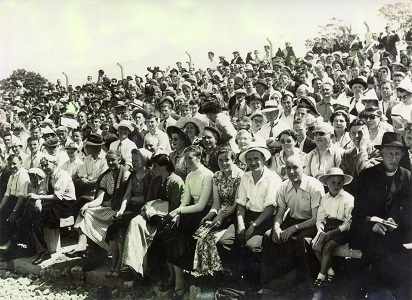
by Tom Kenny
June 16th, 1957 was a blistering hot day, a day of celebration for the Galway GAA fraternity. It was the day the President of the GAA , Seamus McFerran officially opened the Pearse Stadium in Rockbarton.
The idea of the stadium originated with a meeting of 6 members of the Borough Council, 6 members of the Chamber of Commerce and 6 members of the GAA. The Mayor acted as chairman and a 17 acre site which was known locally as “The Boggers” in Rockbarton was chosen.. The site was offered to the GAA by the Town Secretary, Seán Gillan. It was very wet and boggy, but as it happened, they were deepening the river at the time so they used a lot of the infill partly on the pitch, but also to give the pitch an elevated sideline. The pitch itself was one of the largest in the country, the construction work was done by the Salthill firm James Stewart & Co. and cost £34,000, a figure that seemed staggering at the time.
OUR LADY'S BOYS CLUB
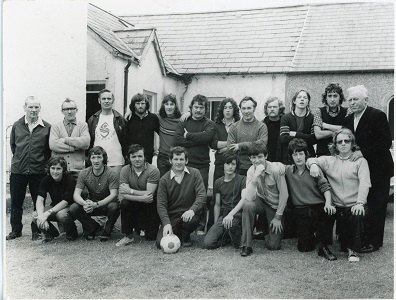
by Tom Kenny
This club has been a source of guidance and inspiration to the youth of Galway, especially those of working class background, since its foundation by Fr. Leonard Shiel S.J., a priest of great vision, in 1940. Indeed this wonderful structure owes a great debt to the Jesuit Order. Since the beginning the club has been based behind the Columban Hall in Sea Road. From the first nervous day of membership, right through their teens, and even in adult life the spirit and ever watchful eye of the club is with the boys.
